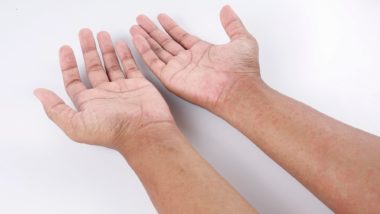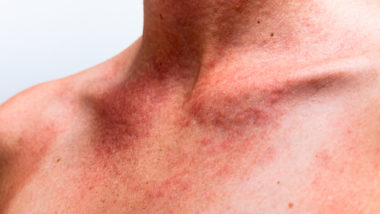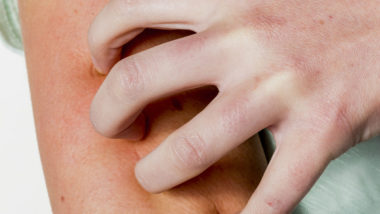Top Class Actions’s website and social media posts use affiliate links. If you make a purchase using such links, we may receive a commission, but it will not result in any additional charges to you. Please review our Affiliate Link Disclosure for more information.
 What is Lamictal?
What is Lamictal?
Lamictal is an anti-convulsant medication, also known by its generic name, lamotrigine. Lamictal is made by GlaxoSmithKline. The drug is mostly used to prevent seizures, but can also be used as a treatment for bipolar disorder, neuropathic pain, and depression, says Healthline.
Some patients may develop side effects when taking Lamictal. One of the most common Lamictal side effects is a rash — about 10 percent of people taking the medication may develop a Lamictal rash. Another concern is that the drug could cause SJS.
How Does Lamictal Work?
Lamictal is part of a class of prescription drugs known as sodium channel blockers. These medications suppress the conduction of sodium ions through sodium channels. This is a form of cellular communication, which facilitates a wide range of physiological processes, including nervous system function, voluntary and involuntary muscle movement and cardiac rhythm. Not surprisingly, such medications are used to treat arrhythmia (irregular heartbeat). Because of their significant role in signaling in the body, sodium channels are common targets when developing medications for the treatment of chronic pain and other pathologies.
Some sodium channel blockers are broad-spectrum, while others are more selective, targeting specific pathways. Lamictal is one of the former. Because of this, it is useful not only for preventing epileptic seizures, but also for the depression phase of bipolar disorder. It also has fewer side effects than other types of anticonvulsants, such as phenytoin (Dilantin).
Is Lamictal Used to Treat Anything Else?
In addition to epileptic seizures and bipolar disorder, Lamictal may be prescribed off-label for a number of other neurological disorders (“off-label” means that the medication has not been approved by the FDA for a particular condition, but may be prescribed by a licensed physician or psychiatrist if, in their professional opinion, it would benefit the patient).
Additional off-label indications for Lamictal include:
- peripheral neuropathy (nerve damage)
- trigeminal neuralgia (facial pain)
- cluster headaches and migraines
- visual static
Psychiatrists may also prescribe Lamictal for:
- obsessive-compulsive disorder (OCD)
- depersonalization disorder (DPD)
- persistent hallucinations
- schizophrenia and mood disorders
What is the Lamictal rash?
Medical News says that a Lamictal rash usually presents itself within the first eight weeks of Lamictal usage. Usually, the rash is not serious. However, in rare circumstances, the rash can be a sign that a more serious, life-threatening condition is developing. Medical News says that the rash is dangerous to some; around 0.08 percent to 1.3 percent of patients are at risk.
Can Lamictal cause SJS?
A Lamictal rash may develop into a number of serious conditions, including the following:
- Stevens-Johnson syndrome (SJS)
- Toxic Epidermal Necrolysis
- DRESS syndrome (drug reaction with eosinophilia and systemic symptoms)
- Hemophagocytic lymphohistiocytosis
- Drug-induced hypersensitivity syndrome
What is SJS?
SJS, or Stevens-Johnson syndrome, is an allergic reaction to a drug. It is a serious condition that affects the skin and mucous membranes. When the condition develops, in connection with Lamictal or another drug, it may result in blisters and burns. In the case of some patients, these blisters and burns may cover up to 30 percent of a patient’s body.
Around 50 percent of patients who develop Stevens-Johnson Syndrome develop the condition in connection with their use of a drug.
When a possible Lamictal rash is at risk of developing into a more serious condition, the affected patient may show the following signs:
- peeling skin
- painful blisters
- inflammation and swelling in the eye area
- body aches
- flu-like symptoms
- coughing
- inflammation of lymph nodes
What is Toxic Epidermal Necrolysis?
Unfortunately, there is an even more severe type of Stevens-Johnson Syndrome, known as TEN. When Stevens-Johnson Syndrome develops into Toxic Epidermal Necrolysis, the affected skin makes up more than 30 percent of a person’s skin.
Genetics Home Reference notes that SJS and toxic epidermal necrolysis were once considered separate conditions, they are now seen as part of the same condition, with Stevens-Johnson syndrome being the less severe version of the condition and toxic epidermal necrolysis being its more severe stage. Both SJS and TEN can be deadly.
Patients who worry that Lamictal can cause SJS should be aware that in addition to the percentage of SJS cases developing in connection with an adverse drug reaction, around 95 percent of Toxic Epidermal Necrolysis cases develop in connection with an adverse reaction to a drug.
How are SJS and TEN treated?
Treatment for SJS and Toxic Epidermal Necrolysis are initially treated by eliminating the cause of the condition. If a doctor thinks that Lamictal may cause SJS in a patient, they may have the patient stop taking the drug in the hopes of helping a patient recover from SJS. The conditions are serious, and are considered medical emergencies, says Mayo Clinic. Recovery may take weeks or months, depending on the severity of the reaction.
If you or a loved one developed a Lamictal rash or other serious Lamictal side effects, you may qualify to pursue compensation by filing a Lamictal lawsuit. See if you qualify by filling out the short form on this page. It’s absolutely free to participate, so act now!
ATTORNEY ADVERTISING
Top Class Actions is a Proud Member of the American Bar Association
LEGAL INFORMATION IS NOT LEGAL ADVICE
Top Class Actions Legal Statement
©2008 – 2024 Top Class Actions® LLC
Various Trademarks held by their respective owners
This website is not intended for viewing or usage by European Union citizens.
Get Help – It’s Free
Join a Free Lamictal Lawsuit Investigation
If you believe your diagnosis was caused by Lamictal, you may be entitled to compensation by filing a Lamictal lawsuit. Learn more by filling out the form on this page for a free case evaluation.
An attorney will contact you if you qualify to discuss the details of your potential case.
PLEASE NOTE: If you want to participate in this investigation, it is imperative that you reply to the law firm if they call or email you. Failing to do so may result in you not getting signed up as a client or getting you dropped as a client.
Oops! We could not locate your form.

 What is Lamictal?
What is Lamictal?










